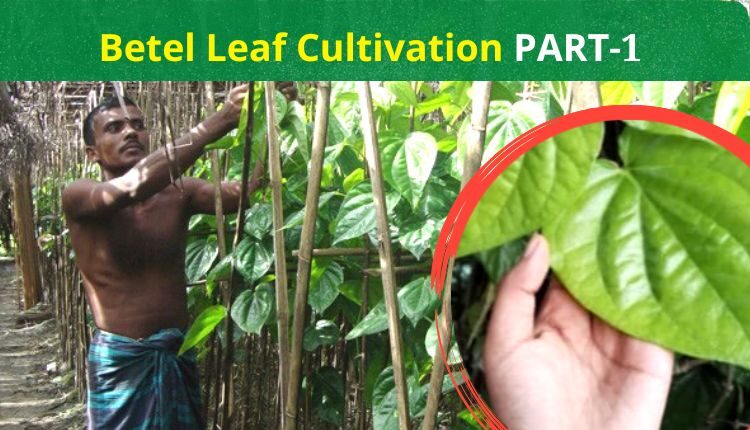To make Betel Leaf Farming safe and economical, adopt the technology of ‘Shade-Net House’ and increase earnings
It is more profitable to cultivate betel in a modern shade-net house instead of the traditional bareja.
Betel leaf has an important place among Indian horticultural crops, as the area under betel cultivation in the country is more than 55 thousand hectares. The livelihood of about 2 crore people is related to the business of betel leaves. Its annual turnover is Rs 800 crore. Betel is cultivated all over India-West except in the north-western states. In states like Bengal, Assam, Bihar, Uttar Pradesh, Madhya Pradesh, Maharashtra, Odisha, Tripura, Andhra Pradesh, Karnataka, Tamil Nadu and Kerala, betel is cultivated on a large scale.
Betel is a cash crop. Most of the farmers associated with its cultivation belong to small and marginal sections. They also produce betel leaves by taking the fields of others on lease. Betel cultivation is considered to be a laborious and sensitive work, because betel crop requires more irrigation and less sunlight. It is very prone to natural calamities like cold winter, heat wave in summer and water logging in rain. The traditional shady structure or protection schools needed for betel cultivation is called bareja or bhita or baretha.
If betel is cultivated inside the modern shade-net house instead of bareja, then it proves to be very beneficial for the betel producing farmers. Since the shade-net house is more durable than bareja, it protects the betel leaves from cold wave, heat wave and water logging. When betel is grown in shade-net house, the attack of diseases and pests on the crop is also less. It is easy to install foggers for temperature control and drip irrigation facilities for irrigation in a shade-net house. For its construction, grant facility is also available to the betel producing farmers from the National Horticulture Mission.

Paan’s birthplace
Paan is called Betel in English. Its botanical name is Piper betle. It is a member of the ‘Piperaceae’ family and is a multi-year, evergreen, dicot, bisexual vine. The birthplace of betel leaves is believed to be in Middle-East Malaysia. It is cultivated there for 2000 years. Betel is cultivated in South-East Asia in India, Bangladesh, Malaysia, Sri Lanka, Pakistan, Thailand, Singapore, Maldives, Philippines, Papua New Guinea, Mauritius, Myanmar and South Africa.
More than 100 varieties of betel are found in India. Magahi, Bangla, Calcutta, Sanchi, Karpoori, Mahobai, Meetha Patta etc. are the main Indian varieties of paan. Betel experts from the Lucknow-based Council of Scientific and Industrial Research–National Botanical Research Institute, CSIR-NBRI have classified major varieties on the basis of the composition of betel leaves and the chemical properties of the volatile oils present in it.
Medicinal properties of betel leaves
Betel leaves contain volatile oils with anti-carcinogenic and medicinal value like ‘hydroxycavicol’ and ‘eugenol’. Apart from this, betel also contains amino acids, carbohydrates, mineral salts, calcium, phosphorus, iron and vitamins. The juice of betel leaves has been found useful in treating cough, anthelmintic, sedative and respiratory problems. Betel leaf reduces the effect of bacteria that cause bad breath in the mouth. The catechu, clove, cardamom and fennel used in betel leaves are also helpful in keeping the mouth fragrant.
Consumption of betel aids in digestion. It increases the activity of the salivary glands of the mouth, which makes the digestion of food into small pieces easier. That is why chewing betel leaves is beneficial for those suffering from constipation. Paan also removes mucus. Its use is beneficial if there is a knot or swelling in the gums. Putting paan with salt and carom seeds in the mouth before sleeping helps in getting good sleep. Taking it mixed with honey provides relief in cold and flu.
The volatile oils of betel nut have analgesic properties. This gives relief in headache. Applying a paste of turmeric and mustard oil with betel leaves even if there is a sprain or injury. Consumption of betel leaves is also beneficial in dry cough. Betel leaves are also used in many religious rituals, festivals and auspicious occasions apart from catechu-lime beads.

Advanced technology of betel cultivation
The temperature of 15 to 40 degree celsius is favourable for betel cultivation. It needs a lot of moisture and less sunlight. That is why in South and North-East India, betel cultivation is done under the open sky even in the fields of betel nut trees, because the betel gets as much sunlight as it needs under the shade of tall betel trees. But in North Indian states, a special kind of shady hut structure is made for the cultivation of betel leaves. It is called the conservation house of betel vines or Bareja. Traditionally, Bareja is made using bamboo, tur or jute stalks, paddy straw, sarkanda (ikri) and coconut rope.
The roof or thatch of Bareja is called Maro, Madwa, Chhani or Thathara. Due to this, sunlight reaches the betel vines by filtering or in small quantities. The four walls of Bareja are called tat. It protects the betel crop from cold wave and heat wave. In the field surrounded by bareja, after measuring 3-4 meters long bamboos are buried in the ground at a distance of one meter and then at a height of about 2.5 meters, bamboo shoots are tied on both the length and width and the shape of thatch is given. After pouring paddy straw on thatch roof, they surround the four walls of Bareja with sackcloth.
Bareja expensive task
Thus, making bareja is a labourious and expensive task. Farmers also have to spend every year on its repair. Bareja has to be made extra strong in extreme cold or hot weather. So that the temperature inside the bareja is maintained in the right range. But if modern and advanced technology ‘shade-net house’ is used, then the hassle of making bareja for years and years gets rid of.

Shade-net houses also work with the same technique as poly houses. By making traditional bareja, farmers cultivating betel in it should increase production by reducing their cost by making modern ‘shed-net house’. To get the grant given by the National Horticulture Mission for its construction, farmers should contact their nearest Agriculture Officers or Krishi Vigyan Kendra.
Contact us: If farmers want to share information or experiences related to farming with us, then they can do this by calling us on the phone number 9599273766 or by writing an email to [email protected] or by sending your recording. Through Kisan of India, we will convey your message to the people, because we believe that if the farmers are advanced then the country is happy.
You can connect with Kisan of India on Facebook, Twitter, and Whatsapp and Subscribe to our YouTube channel.



